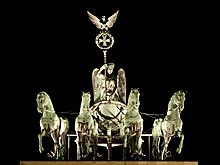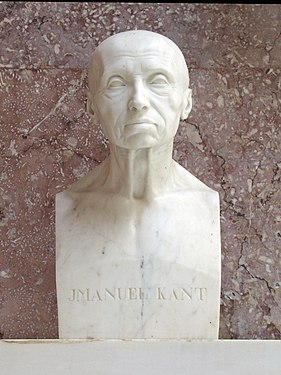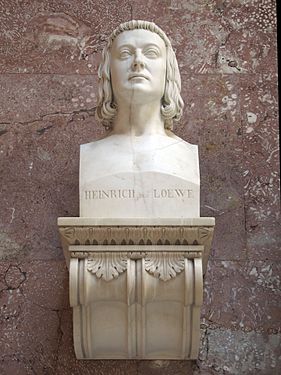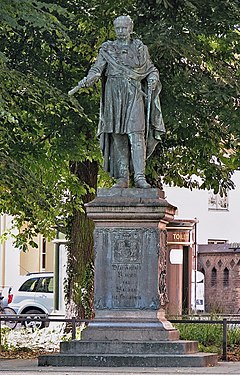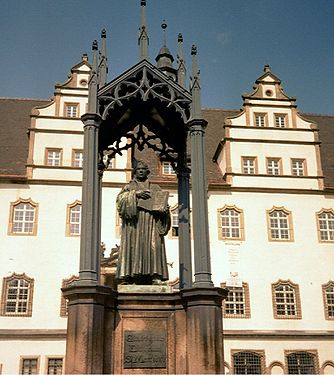Johann Gottfried Schadow
Johann Gottfried Schadow (born May 20, 1764 in Berlin ; † January 27, 1850 there ) was a Prussian graphic artist and the most important sculptor of German classicism . His main works are the tomb of Count von der Mark (1790), the quadriga on the Brandenburg Gate (1793) and the group of princesses , the double statue of the princesses Friederike and Luise von Mecklenburg-Strelitz (1797). Schadow is considered to be the founder of the Berlin School of Sculpture . His students included Christian Friedrich Tieck , Christian Daniel Rauch , Ridolfo Schadow , Emil Wolff and Theodor Kalide .
Life
Childhood and youth
Schadow was born on Lindenstrasse in Berlin near Hallesches Tor . He was the son of the master tailor Gottfried Schadow, b. on January 21, 1738 in Saalow , Teltow district († 1788), and Anna Katharina Nilles, b. on March 20, 1740 in Mellen , Teltow district († 1797). The ancestors were Brandenburg farmers in the Teltow district. The father, physically weak in childhood, became a tailor in Zossen and later moved to Berlin. Johann Gottfried Schadow had four siblings, he was the oldest son.
Schadow first attended the Gray Monastery high school with his brothers. When the father recognized his son's talent for drawing, he had him take drawing lessons from Giovanni Battista Selvino from 1776. Selvino was able to pay off a long-standing wages owed to Schadow's father for tailoring. In 1777 Schadow left school to be instructed in drawing by Madame Tassaert . In autumn 1778 he decided to become a sculptor and became a student of the Prussian court sculptor Jean Pierre Antoine Tassaert , from whom he learned the entire sculptural technique. In 1778 he began his training at the Academy of Arts and attending the nude class.
Italy trip
Tassaert was very fond of his most gifted student; He therefore also sought the family ties of Schadow by marrying his daughter; at the same time Tassaert held out the prospect of his successor as court sculptor. Schadow did not go into this; In February 1785 he ran away with his lover Marianne Devidels to Vienna to see his future father-in-law. On the trip he stayed in Dresden in April 1785 with the portrait painter Anton Graff . With the money from his father-in-law, Schadow traveled on to Italy. In June 1785 he came to Venice , in July he reached Florence and finally Rome . Here he joined Alexander Trippel's workshop for a short time , but then preferred to devote himself to studying antiquity. The following year he received the prize of the Roman Academy with the clay group Perseus liberates Andromeda . He was friends with the German painter Heinrich Füger , the Austrian sculptor Franz Anton von Zauner and the Italian sculptor Antonio Canova .
On August 25, 1785, in Prague , he married the Jewish educated Marianne ("Mattel") Anna Augustine Devidels (born on December 17, 1758 in Prague, died on November 9, 1815 in Berlin), daughter of the Viennese jeweler Samuel Devidels (1731– 1790). Apparently Schadow had met his wife in Henriette Herz's salon in Berlin. In Rome, Schadow converted to Catholicism ; his wife had been Catholic since 1779. In 1786 his son Karl Zeno Rudolf (Ridolfo) Schadow was born in Rome, who became his student and later a successful sculptor himself.
Career in Berlin
After returning to Berlin in 1787, Schadow converted back to Protestantism, not least in order to be able to get a job in the Prussian civil service. First he became a porcelain painter at the royal porcelain factory . Schadow's teacher Tassaert died in January 1788. Then, on the orders of King Tassaert, Schadow took on the last job: the tomb of the Count von der Mark, who died at a young age, in the Dorotheenkirche. He replaced the now superficial Rococo art with the stricter design, based on antiquity . Also in January 1788 he was appointed a full member of the Academy of Arts. He became a teacher of sculpture and one of the five rectors. In February his father died. In September the second son Friedrich Wilhelm was born, who became a well-known painter. In autumn 1788, Schadow succeeded Tassaert. He was appointed head of the court sculptor's workshop and director of sculptures at the Oberhofbauamt. From the collaboration with Carl Gotthard Langhans , the director of the Oberhofbauamt, many joint creations emerged.
In 1793 Schadow modeled the quadriga for the newly built Brandenburg Gate , which was driven into 2 mm copper by Emanuel Ernst Jury in Potsdam . He created the 36-meter-long so-called coin frieze for the Berlin Mint on Werderscher Markt , which was built between 1798 and 1800 .
In October 1802, Schadow visited Goethe in Weimar to prepare a sculpture of him. However, this visit did not have the desired result. On the occasion, Schadow created a bust of Christoph Martin Wieland .
In April 1805 he became vice director of the Academy of Arts. In June he and his family moved into his new house in today's Schadowstraße 10/11 in Berlin-Mitte, which an unknown master builder had built for him at the expense of the state. The classicist building is one of the few town houses from this period that has been preserved.
In 1814 he founded the Berlin Artists' Association and became its chairman. After Schadow had been appointed director of the Royal Prussian Academy of the Arts in 1816 , he stayed in Berlin.
In 1815 Schadow had become a widower. In 1817 he married Caroline Henriette Rosenstiel (1784–1832), daughter of Friedrich Philipp Rosenstiel, in Berlin . He had four children with her, who were born between 1818 and 1824. In the following years he made trips to Dresden (1820), to Wittenberg for the unveiling of his Luther monument (1821), to Wittenberg (1822) and with his brother Rudolf to Hamburg and Lübeck (1823). After the birth of his youngest child Julius (1824), he began to be more politically active and was elected a member of the Berlin parliament in 1827.
With his son Felix he made several trips to Leipzig (1835). In 1836 Schadow had to undergo eye surgery. For the painting and working with the eyes, the restriction of the eyesight was a bitter intrusion into his artistic work. He could only draw and was only rarely active as a sculptor.
Age
In 1839, 75-year-old Schadow applied to have him retired for reasons of age. That was rejected, but he was given a deputy director at his side. Schadow now also dealt with history and therefore became a member of the Association for Mecklenburg History and Archeology in 1840 . Schadow was particularly proud when his son Wilhelm - first his pupil, later an important painter - was raised to the hereditary Prussian nobility. In 1846 Schadow returned to Dresden.
Schadow was still productive even in old age. Towards the end of his life he wrote his memoirs. In 1849 he brought out the art works and art views .
Schadow died peacefully with his children on January 27, 1850 at the age of 85 in Berlin. He was buried in the Dorotheenstädtischer Friedhof in Berlin-Mitte. The honor grave of the city of Berlin is in the department CAL G2.
Memberships in clubs
Schadow was very interested in the game of chess and was co-founder of the first German chess club, often named after him, in Berlin in 1803 . Since 1840 he was a member of the Association for Mecklenburg History and Archeology.
As a Freemason , he belonged to the Berlin Friedrich Wilhelm Lodge for Crowned Justice . He was also active on the board of directors of the Great Lodge Royal York for friendship , for example as a representative of the Great Lodge of Hamburg and as the first head of the Inner East .
children
From the marriage with Marianne Devidels (after the conversion from Judaism to Catholicism: Anna Augustine Weissenau):
- Karl Zeno Rudolf (Ridolfo) Schadow (born July 9, 1786 in Rome; † January 31, 1822 ibid), sculptor
- Friedrich Wilhelm von Schadow (born September 6, 1788 in Berlin, † March 19, 1862 in Düsseldorf), painter
From the marriage with Caroline Henriette Rosenstiel:
- Richard Schadow (February 7, 1818 - August 20, 1918)
- Felix Schadow (born June 21, 1819 - † June 25, 1861)
- Lida Schadow, later married Bendemann (born August 16, 1821; † 1895)
- Julius Schadow (* July 22, 1824; † 1827)
Honors
Awards during his lifetime
- 1788: full member of the Academy of Arts in Berlin
- 1791: full member of the Stockholm Academy of Arts
- 1793: Member of the Art Academy in Copenhagen
- 1812: Member of the Academy of Arts Vienna
- 1814: Member of the Munich Academy of the Arts
- 1830: Appointment as an honorary doctor of philosophy by the Berlin University
- 1838: Award of the Order of the Red Eagle, 2nd class with diamonds, on the occasion of 50 years of membership in the Academy of Arts
- 1842: Order Pour le Mérite for Sciences and Arts , presented by King Friedrich Wilhelm IV in Schadow's apartment
- 1842: full member of the Kassel Art Academy
- 1844: Award of the Swedish North Star Order by King Oskar I.
- 1845: corresponding member of the Paris Académie des Beaux-Arts
- 1846: corresponding member of the Brussels Art Academy
- 1847: Member of the Dresden Academy of the Arts
- 1848: Honorary member of the Cologne Carnival Society
- 1848: Awarded the star for the Order of the Red Eagle, 2nd class
Posthumous honors
In 1851, a bronze statuette of Schadow based on the model of his pupil Heinrich Kaehler was placed on Schadow's grave . It can be viewed at the Dorotheenstadt cemetery .
With the construction of the Düsseldorf Art Academy (1875–1879), his name was carved into the frieze of the facade on the west side (Rhine side) among the important sculptors.
In addition, in honor of Schadow, a relief with his portrait was placed on the bench of monument group 30 in the former Siegesallee in Berlin . The sculptor of the group was Gustav Eberlein , the unveiling took place on March 30, 1901.
In 1993 the asteroid (5265) Schadow was named after him.
Conception of art
Schadow was an artist who always adhered to the classical and naturalistic conception of art. Since 1800 at the latest, he found himself in constant conflict with the emerging romantic idealistic conception of art, which was embodied by his students. One of his most important students was Christian Daniel Rauch . Other important students were his sons Rudolf and Wilhelm as well as Friedrich Tieck , Karl and Ludwig Wichmann . This applies to Karl Friedrich Schinkel , through whom he was forced out of the management of the Oberhofbauamt.
As is well known, Schinkel increasingly freed himself from the academic, classical language of form with his architectural designs . Initially, Schadow had made the sculptural decorations for the buildings designed by Schinkel in the classical style. Gradually, however, Schadow was sidelined by the new artistic tendencies and was later commissioned by the Prussian royal family with only a few works.
Schadow increasingly turned away from the old classical language of forms and towards the new romantic, without ever giving it up completely. This, in turn, took place after the death of Friedrich Wilhelm II in 1797, who had been Schadow's patron and patron.
Schadow tried all his life to create a public equestrian statue of King Frederick the Great . This never happened, however, only a few statues such as the bronze statue of Friedrich with his dogs Alcmène and Hasenfuß or the statue in Stettin were made by Schadow. The equestrian statue of Frederick the Great , on the other hand, was created by Christian Daniel Rauch .
Works (selection)
Tombs


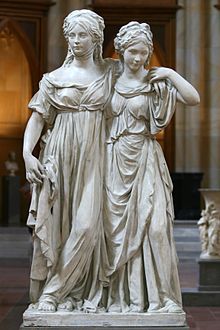
- 1790: Tomb of Count Alexander von der Mark (Berlin, Alte Nationalgalerie ). The prince's tomb established the reputation and subsequent success of Schadow as an important sculptor of his time through the compassionate portrayal of the child. Made in marble and installed in 1790. Today in the Alte Nationalgalerie in Berlin.
- 1795: Tomb for Anton Friedrich Büsching (Berlin, Märkisches Museum ). In 1871 the tomb was relocated to the Neue Georgenfriedhof for urban planning reasons, and in 1935 again to the refectory of the Gymnasium zum Grauen Kloster, which Büsching was once director of. It has been exhibited in the Märkisches Museum since 1950, including the restored inscription plaque since 2001.
- 1798: Tomb of Friedrich Wilhelm Schütze in the Schlosskirche Schöneiche .
- 1816: Tomb for Marianne Schadow (1758–1815), b. Devidels, the artist's first wife. After a happy marriage, Marianne Schadow died at the age of 57 and was buried in the St. Hedwigsfriedhof in front of the Oranienburger Tor. After the cemetery was closed, the marble grave monument was transferred to the municipal cemetery in Liesenstrasse in 1901 and from there it was moved to the Märkisches Museum in 1928 , where it is now located in the Great Hall.
Busts
- 1783: Bust of Henriette Herz
- 1794–1795: Busts of the princesses Friederike and Luise von Mecklenburg-Strelitz as preparatory work for the princess group
- 1800: marble bust of Carl Friedrich Christian Fasch , founder of the Sing-Akademie zu Berlin
- 1801: bust of Friedrich Gilly
- 1807: Marble bust of Julie Zelter (née Pappritz), wife of Carl Friedrich Zelter , director of the Sing-Akademie zu Berlin
- 1807–1811: several portrait heads in the Walhalla near Regensburg, one and a half times life size (see list of busts in the Walhalla )
- 1823: Goethe bust (sculpture collection of the Alte Nationalgalerie in Berlin). Schadow had already made a presentation to Goethe in Weimar in 1802 , but had suffered a rebuff with his request to measure his head in order to make a bust. That is why the bust was not created until 1823 after a living mask by Carl Gottlieb Weisser from 1815.
- Several busts by Christoph Martin Wieland .
- Busts in the Walhalla near Regensburg
Nicolaus Copernicus (1807)
Immanuel Kant (1808)
Henry the Lion (1811)
More sculptures
- 1793: Quadriga (Berlin, group of sculptures on the Brandenburg Gate ). King Friedrich Wilhelm II had the Brandenburg Gate built as a gate of peace in memory of his predecessor Friedrich the Great. The highlight is the quadriga crowning the building, a team of four in front of a chariot driven by the winged goddess of victory, Victoria, who brings peace. The gate was badly damaged in the Second World War, and a horse's head from the original Quadriga has been preserved in the collection of the Stadtmuseum Berlin Foundation . From 1948 onwards, as a result of the division of Berlin, the Brandenburg Gate was located on the border between East and West Berlin . The Quadriga was reconstructed in 1958 in a difficult collaboration between the two halves of the city.
- 1794: Zieten monument (Berlin, Bode Museum ). Bronze replica on Wilhelmplatz .
- 1795–1797: the group of princesses , an antique double statue of the princesses Friederike and Luise von Mecklenburg-Strelitz . 1795: plaster model, today in the Friedrichswerder Church . 1797: Executed in marble, today in the Alte Nationalgalerie.
- 1800: Monument to Prince Leopold I of Anhalt-Dessau (Berlin, Bode Museum). Bronze replica on Wilhelmplatz .
- 1809 or shortly before: Luisen-Stein (Berlin, on an island in the Tiergarten ).
- After 1811: apotheosis of Queen Luise of Prussia (relief in the Paretz village church , patron's box ).
- 1819: Blücher monument in Rostock made of copper (see below). Goethe had contributed to the conception.
- 1820: Construction of the lion fountain on Naschmarkt in Leipzig with two iron lions, which were cast according to Schadow's designs in the Lauchhammer art and bell foundry .
- 1821: Monument to Martin Luther , erected on the market square in Wittenberg (see below).
- 1822: Bronze statuette of Friedrich II with his greyhounds . The 91 cm high bronze statue of Frederick the Great with his favorite dogs is now in the Bode Museum in Berlin. Schadow's sketch of the dogs' faces was also preserved. The statue was not taken with general benevolence, as statements by Field Marshal Friedrich von Kleist indicate. Nevertheless, it shaped the idea of the figure of "Old Fritz" in the following generations. It is reproduced in porcelain to this day, both in original size and in miniature , among others in the Porcelain Manufactory Sitzendorf and the Aelteste Volkstedter Porcelain Manufactory .
- 1840: Sculpture in the lifting temple in Neustrelitz in Mecklenburg-Strelitz. A circle of Ionic columns frames a figure of Hebe, created around 1840 based on the model of the Hebe figure created by Antonio Canova in 1796 . The original of the statue, a copy of which was placed in the middle of the temple in 1856, is in the Berlin State Museums .
Blücher monument in Rostock
Graphic works

Schadow created more than 2,200 etchings and lithographs . In his later years he increasingly turned to graphics and worked as a cartoonist . Some of his caricatures, especially those of Napoleon Bonaparte , come close to the quality of the English caricaturist George Cruikshank . One example is the cartoon fencing lesson from 1814. His interest in physiognomics is shown, among other things, in the drawing of Harry Maitey , who was the first Hawaiian to come to Prussia in 1824.
Art theoretical writings
- 1830: Doctrine of the Bones and Muscles .
- 1834: Polyklet or by the masses of men according to gender and age .
- 1835: National physiognomies or observations on the difference in facial features and the external shape of the body .
- 1849: Works of art and art views. A source work on Berlin's art and cultural history between 1730 and 1845. Reprint Götz Eckard, 3 vol., Berlin 1987.
- 1825 Wittenberg's monuments of sculpture, architecture and painting, with historical and artistic explanations . Wittenberg, Zimmermannische Buchhandlung. Reprint 1993.
See also
literature
- Gottfried Schadow, Julius Friedländer (Ed.): Essays and letters . Düsseldorf 1864
- Lionel von Donop : Schadow, Johann Gottfried . In: Allgemeine Deutsche Biographie (ADB). Volume 30, Duncker & Humblot, Leipzig 1890, pp. 498-512.
- Schadow, 1) Johann Gottfried . In: Meyers Konversations-Lexikon . 4th edition. Volume 14, Verlag des Bibliographisches Institut, Leipzig / Vienna 1885–1892, p. 377.
- Hans Mackowsky: Schadows graphic . Berlin 1936 (research on German art history 19)
- Hans Mackowsky , Paul Ortwin Rave (ed.): The sculptures Johann Gottfried Schadows . Berlin 1951
- Kurt Magritz: Johann Gottfried Schadow (on his 190th birthday on May 20, 1954) . In: Deutsche Architektur Heft 3, born 1954, pp. 124–127
- Peter Bloch, Sibylle Einholz, Jutta von Simson (eds.): Ethos and Pathos. The Berlin School of Sculpture 1786–1914 . Exhibition catalog Berlin (Museum Hamburger Bahnhof) 1990, 1st volume catalog, 2nd volume essays and short biographies
- Götz Eckardt: Johann Gottfried Schadow (1764-1850): The sculptor . Leipzig 1990. ISBN 3-363-00408-7
- Ulrike Krenzlin : Johann Gottfried Schadow. An artist's life in Berlin . Stuttgart - Berlin 1990. ISBN 3-345-00467-4
- Bernhard Maaz (Ed.): Johann Gottfried Schadow and the art of his time: Kunsthalle Düsseldorf [5. November 1994 - January 29, 1995], Germanisches Nationalmuseum, Nuremberg, [30. March - June 18, 1995], Nationalgalerie Berlin [14. July - September 24, 1995] . With contribution by Peter Bloch… [et al.], Cologne 1994
- Beate Christine Mirsch: Grace and beauty. Schadow's group of princesses and their position in the sculpture of classicism . Berlin 1998, ISBN 978-3-87157-179-4
- Günter de Bruyn : Prussia's Luise. About the creation and decay of a legend . Berlin 2001
- Knut Brehm, Bernd Ernsting, Wolfgang Gottschalk, Jörg Kuhn: Stiftung Stadtmuseum Berlin, catalog of the sculptures 1780-1920 . (LETTER writings), Cologne 2003
- Jutta von Simson: Schadow, Johann Gottfried. In: New German Biography (NDB). Volume 22, Duncker & Humblot, Berlin 2005, ISBN 3-428-11203-2 , pp. 496-498 ( digitized version ).
- Sibylle Badstübner-Gröger, Claudia Czok, Jutta von Simson, Rüdiger Beckmann (eds.): Johann Gottfried Schadow. The drawings . With an introductory essay by Werner Hofmann. 3 volumes, Berlin 2006. ISBN 978-3-87157-190-9
- Bernhard Maaz (Hrsg.): National Gallery Berlin, catalog of the pictures, Das XIX. Century . 2 vols., Leipzig / Berlin 2006
- Thomas Blisniewski : Johann Gottfried Schadow. The drawings . Deutscher Verlag für Kunstwissenschaft, Berlin 2006, in: sehepunkte 7 (2007), No. 5 from May 15, 2007 ( online )
- Reimar Lacher: Schadow's group of princesses. The beautiful nature . Story Verlag, Berlin 2007, ISBN 978-3-929829-67-9
- City Museum Berlin Foundation and Schadow Society Berlin e. V. (Ed.): Our Schadow. Congratulations on your 250th birthday. Exhibition catalog, Berlin, 2014
Web links
- Literature by and about Johann Gottfried Schadow in the catalog of the German National Library
- Works by and about Johann Gottfried Schadow in the German Digital Library
- http://www.schadow-gesellschaft.org/ (Celle; founded 1985)
- http://www.schadow-gesellschaft-berlin.de/
- Schadow: Works of art and views of art, Berlin, 1849 ( digitized version , Bavarian State Library )
Remarks
- ^ Catalog National Museums in Berlin, National Gallery, 1964
- ↑ Götz Eckkardt, Schadow, The Sculptor, EA Seemann Verlag, Leipzig, 1990
- ↑ Meyers Konversations-Lexikon, 4th ed. 1888-1890, Vol. 14, p. 377 f.
- ^ Eugen Lennhoff, Oskar Posner, Dieter A. Binder: International Freemason Lexicon . Special prod. 1st edition, Herbig: München 2006, p. 744.
- ^ Jan Mende: Schadow, the Freemason , in: Stiftung Stadtmuseum Berlin and Schadow Gesellschaft Berlin e. V. (Ed.): Our Schadow. Congratulations on your 250th birthday. Exhibition catalog, Berlin, 2014, pp. 90–95.
- ↑ Knut Brehm, Bernd Ernsting, Wolfgang Gottschalk, Jörg Kuhn: Stiftung Stadtmuseum Berlin , catalog of pictorial works 1780–1920. Letter Schriften, Cologne 2003, p. 238 ff.
- ↑ Knut Brehm, Bernd Ernsting, Wolfgang Gottschalk, Jörg Kuhn: Stiftung Stadtmuseum Berlin , catalog of pictorial works 1780–1920. Letter Schriften, Cologne 2003, p. 244 ff.
- ↑ Schelling wrote to Schlegel on October 13, 1802 : “Imagine the flatness of Schadow, that he asked Goethen right after the first welcome to be able to measure his head. Goethe said he had asked the Sultan, like the Oberon, for a few molars and hair out of his beard. According to the impression he made on Goethe, he must have acted like a beer brother to him. "E. Arnhold, Goethe's Berlin Relations , o. O. and J. ( PDF; 2.2 MB ( Memento from 1. May 2006 in the Internet Archive )), p. 236.
- ↑ CT examination: Goethe's second mask just a simple copy. In: Spiegel Online . May 16, 2007, accessed February 27, 2015 .
| personal data | |
|---|---|
| SURNAME | Schadow, Johann Gottfried |
| BRIEF DESCRIPTION | Prussian sculptor and graphic artist |
| DATE OF BIRTH | May 20, 1764 |
| PLACE OF BIRTH | Berlin |
| DATE OF DEATH | January 27, 1850 |
| Place of death | Berlin |






